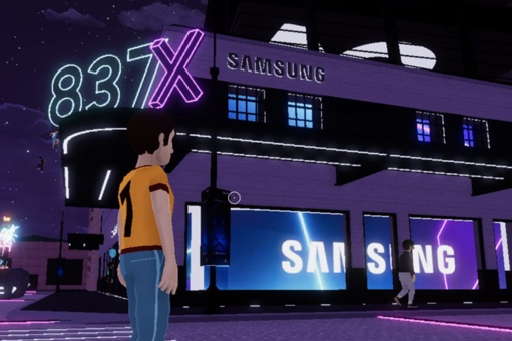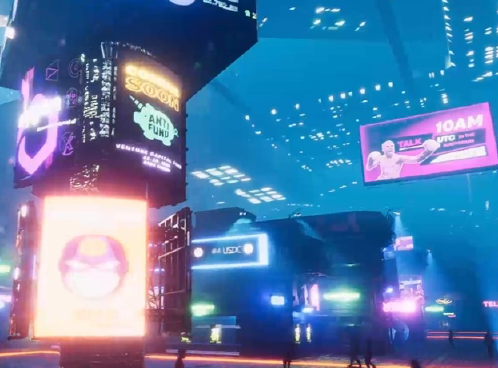
DIpil Das
Introduction
What’s the Story? The metaverse, a virtual reality space where users can interact with one another, is not just a buzzword. It has been in development for decades, butCoresight Research has identified the expanding metaverse as a key trend to watch in retail in 2022 and beyond, as new technologies continue to emerge and evolve that support the development of virtual environments and digital opportunities as part of “Web 3.0” (the third version of the Internet, which allows users to have greater control over their digital assets and identities). In this report, we explore three unique virtual environments—Decentraland, The Sandbox and Bloktopia—covering their backgrounds, structures and strategies, and the attractive virtual real estate opportunities they offer brands and retailers.- For more on recent developments related to the virtual land-grabbing craze, see the first report in our new Metaverse Latest series.
Figure 1. Impact of AR/VR/MR on Global GDP (USD Bil.) [caption id="attachment_142815" align="aligncenter" width="700"]
 Sources: PwC/Statista [/caption]
Sources: PwC/Statista [/caption]
The Virtual Land Grab: Coresight Research Analysis
1. The Blockchain-Driven Metaverse: Decentraland, The Sandbox and Bloktopia Many virtual environments, such as Fortnite and Roblox, already boast active economies and are actively partnering with retailers. However, these non-blockchain games are not interoperable with Decentraland, The Sandbox and Bloktopia—nor are these metaverse platforms interoperable with one another, even though they are built on the same (or compatible) blockchains. This means that users cannot yet bring digital assets (or avatars) with them across environments. Until interoperability is more commonplace, businesses that want to establish a virtual presence have a big choice to make about what they want their digital offerings to include, and each of the three metaverse platforms offers different opportunities. In Figure 2, we present key information about each platform and its land/tokenization strategies.Figure 2: Decentraland, The Sandbox and Bloktopia: Key Information
 Decentraland
Decentraland |
 The Sandbox
The Sandbox |
 Bloktopia
Bloktopia |
| Founder(s)/Management | ||
|
|
|
| History and Funding | ||
|
|
|
| User Base | ||
|
|
N/A—March 2022 launch |
| Blockchain | ||
|
|
|
| Land and Asset Information | ||
|
|
|
| Tokenomics | ||
|
|
|
As of February 28, 2022 Source: Coinbase/company reports/Crunchbase/NFT Plazas 2. Platform Appeal and Virtual Property Sales Revenues generated from virtual gaming worlds could grow from $180 billion in 2020 to $400 billion in 2025, at a CAGR of 17.3%, as estimated by Ark Invest. Additionally, the market value of gaming and esports is currently projected at $1.28 trillion, and the market value of the Web 2.0 stage of the Internet is $14.8 trillion, according to Grayscale Investments. Despite these large numbers, however, the current Web 3.0 market size is only $28 billion, Grayscale estimates. As the evolution toward Web 3.0 continues, and gaming continues to surge in popularity, many businesses involved in Web 2.0 and gaming will begin to shift their strategies for virtual compatibility on decentralized technologies, meaning that the Web 3.0 market size should increase steadily and substantially as AR and VR become ingratiated into everyday life. Republic Realm, which purchased the most expensive piece of virtual real estate in the metaverse, sold the plots it originally owned in early 2021 for $15,000 each. The company’s CEO, Janine Yorio, said that the same plots are selling for $300,000 almost a year later, similar to the US’s median home price in 2021, demonstrating the recent surge in popularity and rapidly increasing entry costs into the virtual world. Decentraland, The Sandbox and Bloktopia are aiming to partner with external businesses, brands and retailers to improve the offerings and experiences of their environments, meaning that prices will likely only continue to climb. The structures of the in-world economies offer brands and retailers compelling opportunities to enter completely new markets and offer avatars from every corner of the globe the same immersive experience, in a new, “direct-to-avatar” business model. Each game also offers different NFT structures to verify the ownership and authenticity of assets. With limited token and land supply, as the shift to Web 3.0 is fully realized and these environments grow, land parcels and respective cryptocurrencies (MANA, SAND, BLOK) become more valuable (and therefore more expensive) as digital foot traffic increases. Various NFT structures allow for attractive in-world economies, as we discuss for each platform below. In addition, each game is continually working on new types of NFTs to provide exclusive ownership of in-game assets and digital items. Decentraland
- Ownership and Security of Digital Assets
- Ownership and Security of Digital Assets
- Use of Marketplace
- Ownership and Security of Real Estate
- Ownership and Security of Advertising
 Companies such as Samsung can build virtual stores and advertise in Decentraland
Companies such as Samsung can build virtual stores and advertise in Decentraland Source: Decentraland[/caption]
Figure 3. Purchases of Land in Decentraland by Brands and Businesses Over the Past 12 Months [wpdatatable id=1800 table_view=regular]
Source: Company reports/Coresight Research The Sandbox The Sandbox, though based on a decentralized autonomous organization model, has much more structure in terms of its path moving forward. Owners of SAND currency and LAND NFTs are given the right to vote in governance decisions and decisions regarding content and game creators. With VoxEdit, the Marketplace and Game Maker, The Sandbox has ambitious plans to grow its monthly active users to 1 million over the next few years. With strong economics and promising plans for growth, The Sandbox offers enticing opportunities for businesses looking to build a presence in the metaverse as creators. The more users, the more active the marketplace, and the bigger the opportunity to sell ASSETS created via VoxEdit. These assets, for use by avatars, could be digital artwork or accessories that retailers could create collections from. For example, Gucci designers are using the VoxEdit and Game Maker tools to design collections for The Sandbox avatars and an in-game retail experience modeling the Vault e-commerce store. Like Decentraland’s NFTs, The Sandbox’s NFTs can be sold on marketplaces such as OpenSea, giving businesses the power to expand customer base to people not active on The Sandbox. Each parcel of land comes with a pre-set terrain, but owners can adjust to fit their goals/specifications. LAND can also be rented to creators who do not own the NFTs to develop their games and share their content with the community. The Sandbox plans to create an ESTATES NFT, which can be owned by multiple users to create themed districts and neighborhoods. Much like Decentraland, The Sandbox will also offer opportunities to advertise in these areas and in areas relevant to a particular brand. Unlike many existing metaverses, Sandbox avatars, ASSETS and LAND can be transferred to other environments, such as Zepeto, a non-blockchain virtual reality. SAND holders are also able to participate in staking, where a user commits holdings to secure a blockchain network and confirm transactions, and earn CATALYST and GEM NFTs in return, which can be used to define avatar attributes and establish their scarcity. Staking to earn GEM and CATALYST NFTs is another potential source of revenue for businesses in The Sandbox. As digital avatars and style will likely become the most important “meta status symbols,” GEM and CATALYST NFTs will become increasingly valuable. [caption id="attachment_142820" align="aligncenter" width="480"]
 Source: The Sandbox[/caption]
Source: The Sandbox[/caption]
Figure 4. Purchases of Land in The Sandbox by Brands and Businesses Over the Past 12 Months [wpdatatable id=1801 table_view=regular]
Source: Company reports/Coresight Research Bloktopia While Decentraland is self-sustaining and The Sandbox is more focused on creators, Bloktopia is focused on growing its user base by utilizing an advanced real-time 3D creation engine to create superior visuals for players. It is committed to partnering with external businesses and offering opportunities for them to monetize the platform through NFTs via sponsorships, advertisements and real estate. By attracting businesses with these opportunities and users with its advanced visuals, Blokopia is hoping to act as a central hub where users can gather in communities to learn and entertain. Because it has not launched yet, however, it does not yet have retailers advertising or developing spaces within its platform, but opportunities will be plentiful when it does launch the beta version in March 2022. To enter the Bloktopia environment, a user must first create a Bloktopia Wallet, where BLOKs are stored; the wallet supports multiple blockchains (opening the door for interoperability) and acts as a player’s e-passport. After creating an avatar (with opportunity for further customization through exclusive NFT assets), characters all “spawn” on Level 1, outside of the Bloktopia skyscraper, meaning this area will have the highest digital foot traffic. This level will feature live cryptocurrency prices, a help desk, resources to navigate the environment, an agenda for upcoming events and the best opportunity for advertising, making it the most expensive to have a presence. Level 1 is where premium brands and retailers will advertise and open stores, with space becoming less valuable the further users travel up the building. This floor will also feature a trading board for latest cryptocurrency prices. Levels will have different environments and interactions for users. For example, Level 21 is a luxury penthouse area reserved for exclusive gaming, such as gambling and poker. Level 6 features an auditorium, where special presentations will be given, rewarding attendees with BLOK; the vision is to create an atmosphere within the auditorium similar to a sports game. The game consists of 21 large advertising totems and 84 small advertising totems (with exclusive ownership through ADBLOK), where businesses will have opportunities to advertise to large audiences with immersive displays. There are four smaller totems on each level and they can display static imagery or videos. Large totems are located in one central location on each level. Bloktopia promises a captive audience and guarantees high dwell times and play-through rates, which should be an exciting prospect for advertisers. From an advertising standpoint, Bloktopia also offers opportunities to advertise on virtual buildings, while Bloktopia Radio, which can be accessed anywhere, anytime, gives users customized programming and ability to listen to stations with specific themes. The radio provides businesses with opportunities to increase their virtual exposure by advertising their events. [caption id="attachment_142821" align="aligncenter" width="480"]
 Source: Bloktopia[/caption]
Source: Bloktopia[/caption]